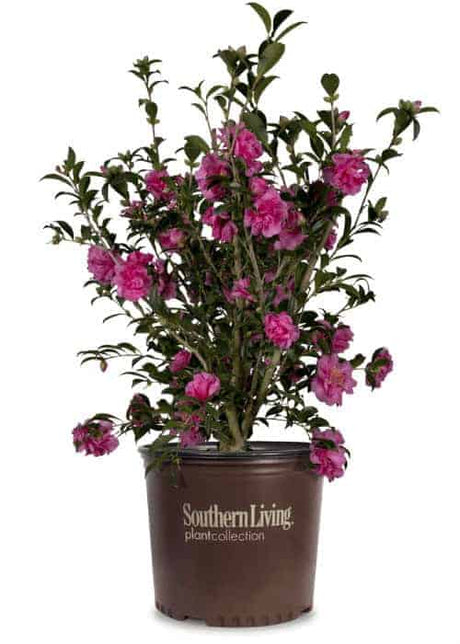Tama Vino Camellia
Tama Vino Camellia - 2.5 Quart is backordered and will ship as soon as it is back in stock.
Couldn't load pickup availability
Description
Description
The 'Tama Vino' Camellia Japonica is an evergreen shrub with pink to red flowers that bloom in the late fall to winter. The 'Tama Vino' has medium-sized, semi-double blooms that are a crisp white on the edges and rich wine-red in the center. When not flowering, this evergreen shrub provides reliable, dark evergreen foliage that quickly becomes a fixture in any landscape. The glossy, dark green leaves make the flowers pop in the garden or indoor cut flower arrangements.
Tamo Vino Camellia Care
Sunlight Requirements for Camellia Japonica Tama Vino
Plant your camellia in a spot with filtered or early morning sun. Avoid placing your Tama Vino Camellia in direct sun between mid-day and afternoon. The afternoon sun can be the harshest on your plants.
Is Camellia Japonica Cold Hardy?
Tama vino camellia is hardy in USDA Hardiness Zones 7-10, which means that it can withstand temperatures down to a minimum average of 0° to 5° F.
If you live north of this area, you can plant these in containers and bring them into a garage or enclosed patio area until warmer temperatures have returned in the spring.
Watering Your Tama Vino Camellia
After unboxing your plant, give it a good drink of water and allow it to rest for a few hours. After you've planted your Tama Vino and applied a layer of mulch, water in the plant to allow the soil and mulch to settle. You can water your camellia japonica weekly for the first year during normal weather conditions. In extreme heat or drought, you may need to water twice weekly to keep the soil from drying. After your Tama Vino has established its root system, you will not need to water your plant regularly, only during times of heat or drought conditions.
When to Prune Camellia Shrubs
It's best to prune camellias over time until you reach the desired shape and size. Camellias, like many other evergreen shrubs, can be pruned to match your desired style. Timing is essential when considering the bud growth on your camellias. The best time to prune is late spring after the bush has finished flowering. Waiting until later in the year could trim off developing flower buds.
Avoid pruning young plants, as they are more susceptible to disease and need as much surface area as possible to maximize their growth. It would be best if you only pruned your camellia every couple of years to avoid the onset of disease.
Fertilizing Camellia Bushes
We suggest fertilizing your camellia japonica bushes twice throughout the year. The first feeding should occur in the spring after the threat of freeze has passed in your area. This feeding encourages growth in your camellia and can be a well-balanced, slow-release fertilizer that will provide nutrients to your Tamo Vino camellia for the spring and summer.
You can fertilize camellias again in midsummer, which helps start a new flush of growth and encourages bud sets. However, young growth can be damaged by cold temperatures, so you'll want this to be mature enough to endure dropping temperatures.
Where to Use Camellia Japonica Tama Vino
Using Tama Vino as a hedge
For a dense hedge, plant your Tama Vino 5 feet apart. Remember, the plants that you receive are young, so this spacing may seem excessive when you plant. Try to avoid jamming these closer when planting, otherwise, you run the risk of stunting their growth and your plants won't get as tall.
Using Tama Vino as a specimen planting
To allow for more space between the plants, space them 12+ feet apart. This will allow them to fully stretch out and provide you with 360° of colorful blooms in the winter. Do this when you're using it as a specimen planting in the landscape. As the plant matures, lower branches can be removed and it can be shaped into a small evergreen tree form with a rounded habit. Specimen plantings are wonderful for clipping during the holidays for cut flower arrangments.
Care & Use
Care & Use
Spacing Recommendations
Spacing Recommendations
-
Scientific Name
-
Hardiness Zone7, 8, 9, 10
-
Sun ExposurePart Sun to Part Shade
-
Evergreen or DeciduousEvergreen
-
FeaturesFlowering, Winter / Fall Foliage Color
-
Feature ColorPink
-
UsesContainer, Cut Flowers, Foundation Planting, Hedge, Mass Planting, Specimen, Woodland Garden
-
Water NeedsMedium
-
Bloom SeasonFall, Winter
Growing Zones : 7, 8, 9, and 10







